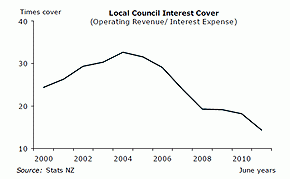
Local government debt levels continue to rise, and pressure on their finances has risen even though their balance sheets remain strong.
Rising debt levels have led to an increase in debt servicing costs, although this has been offset to some extent by lower interest rates.
An ANZ Research note points out that local government debt quadrupled in the decade to 2012, rising from $2 billion to an expected $9 billion this year. (On a per capita basis, that is a rise to $2,000 from $500.)
By 2015 this debt is expected to rise to $11 billion.

More than a third of this debt is owed by Auckland, and ANZ says their current $4.8 billion owing will rise to $12.5 billion in the next ten years as the City looks to borrow heavily to fund its $20 billion capital plan, most of which is for new transport projects including the City Rail Link.
Even though Auckland rate increases are projected to rise by 3.6% this year, and 4.9% out to 2022, a very large number of households will experiece changes significantly different from these averages. A quarter of a million properties will face an 8.1% rise, while on the other end, 187,000 will see a 4.9% decrease.
Despite these higher-than-inflation rises, the borrowing will rise fast too. The ANZ report notes that Auckland's "net debt is projected to peak at around 240% of revenue in 2020" - currently debt levels sit at 175 of current revenues.

Overall, spending growth by NZ councils has outpaced higher revenues, the ANZ report notes. As borrowing has risen, both debt cover and interest cover have fallen, although they are considerably lower than the average corporate balance sheet. The new debt is being added to "an overall starting point that remains strong" ANZ noted. All councils that have sought a credit rating have achieved investment grade so far.
The reported low rates growth for the current year is viewed sceptically by ANZ - the question whether "forecasts will match reality". If costs rise faster than rates revenue, the difference will need to be borrowed.

Local authority credit spreads are significantly higher than pre-GFC levels; however an increasing number of councils are now benefitting from the pooling capabilities of the Local Government Funding Agency (LGFA). Currently the LGFA has 18 councils as shareholders but expects this number to rise to 30 by the end of the year - and perhaps as many as 40 will join by the end of next year. As ANZ points out,
The LGFA benefits from a very strong AA+ (local currency) investment grade credit rating – on a par with the New Zealand Government rating. Standard & Poor’s rating is premised on the view that there is an “extremely high likelihood of extraordinary support from the New Zealand government” but also reflects the LGFA’s strong standalone profile. The LGFA also benefits from access to a $500m liquidity line from the NZDMO and its bonds are repo-eligible with the RBNZ.
ANZ further notes "the LGFA has the potential to issue into offshore markets if pricing stacks up, and this should serve to diversify the investor base over time and lead to spreads compressing to levels closer to those achieved by Kauri issuers."
4 Comments
The annual rates bill growth chart, above, certainly provides an unsustainable contrast when compared with the RBNZ declaration of recent. nominal GDP growth. Ponzi finance dynamics are pervasive at all levels of New Zealander's hope beyond their ability to produce.
The inevitable collapse is not being addressed other than embarking upon new borrowing, which further compounds the problems causing the necessary outcome.
"The LGFA benefits from a very strong AA+ (local currency) investment grade credit rating – on a par with the New Zealand Government rating. Standard & Poor’s rating is premised on the view that there is an “extremely high likelihood of extraordinary support from the New Zealand government” but also reflects the LGFA’s strong standalone profile."
Someone can correct me if I'm wrong here, but I take this statement to mean that by the action of Council's pooling together under the LGFA they are effectively guaranteeing each others' debts? Is that smart? It sounds like a local Council version of the Eurozone! Everyone can borrow at great rates by binding together, but it's a matter of which Council is left standing when the music stops as to who foots the bill... of course, with the 'extreme' likelihood of the Government supporting the LGFA, we're all winners (read - losers).
Bring on the offshore funding for local Councils I say and let's see the awesome mess that's created when our supposedly over-valued NZD resumes normal service around USD$0.60-$0.70 .... If you couldn't see the funny side to insanity you go mad!
If you couldn't see the funny side to insanity you go mad!
How true!!!! - the only thing that keeps me from laughing out loud is the thought about the future these present day posers are writing for my grandchildren.
"The LGFA benefits from a very strong AA+ (local currency) investment grade credit rating – on a par with the New Zealand Government rating. Standard & Poor’s rating is premised on the view that there is an “extremely high likelihood of extraordinary support from the New Zealand government” but also reflects the LGFA’s strong standalone profile."
A laughable claim not realised in reality. All 5 LGFA issues have yielded tender prices reflecting yields much higher than comparable dated NZ Government Stock tender issues.

We welcome your comments below. If you are not already registered, please register to comment.
Remember we welcome robust, respectful and insightful debate. We don't welcome abusive or defamatory comments and will de-register those repeatedly making such comments. Our current comment policy is here.